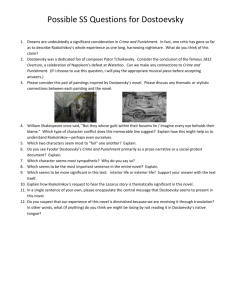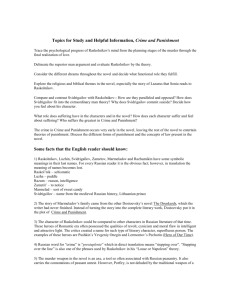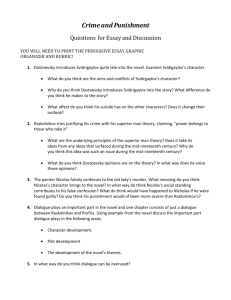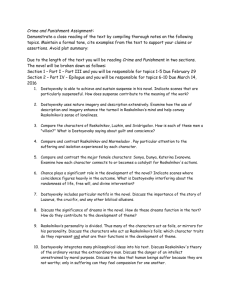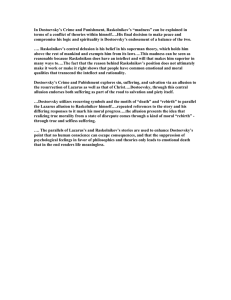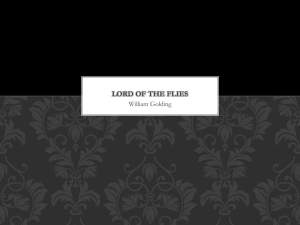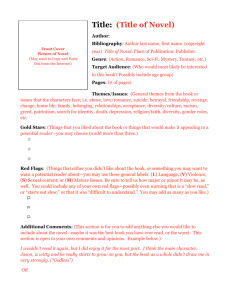Crime and Punishment suggested reading schedule - Parkway C-2
advertisement
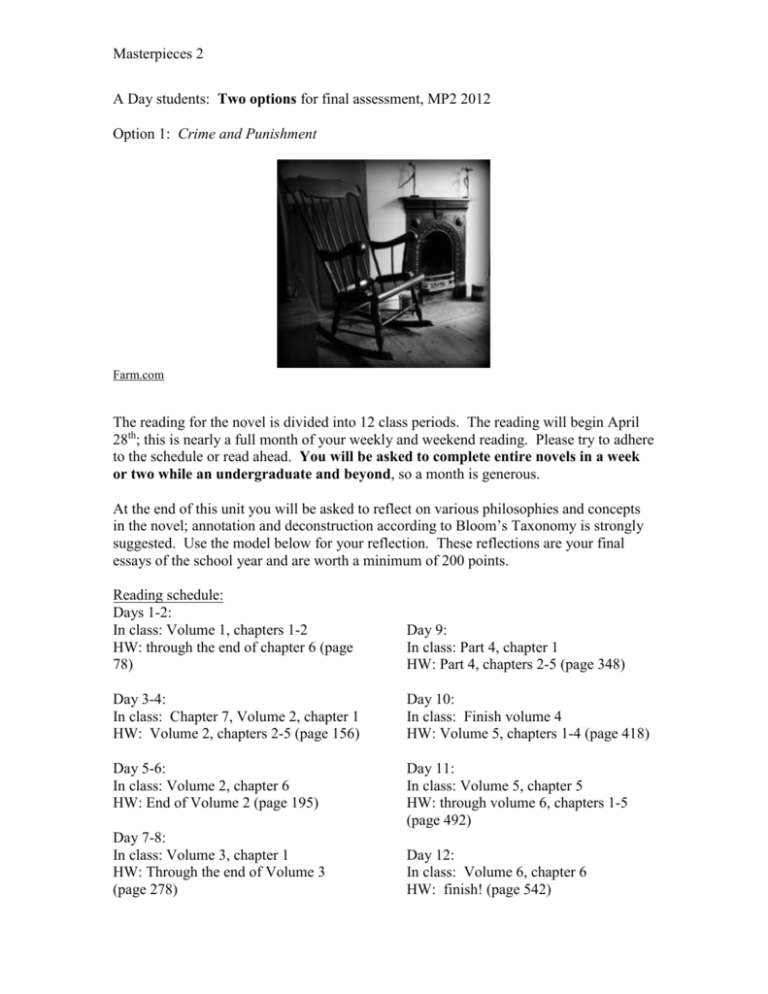
Masterpieces 2 A Day students: Two options for final assessment, MP2 2012 Option 1: Crime and Punishment Farm.com The reading for the novel is divided into 12 class periods. The reading will begin April 28th; this is nearly a full month of your weekly and weekend reading. Please try to adhere to the schedule or read ahead. You will be asked to complete entire novels in a week or two while an undergraduate and beyond, so a month is generous. At the end of this unit you will be asked to reflect on various philosophies and concepts in the novel; annotation and deconstruction according to Bloom’s Taxonomy is strongly suggested. Use the model below for your reflection. These reflections are your final essays of the school year and are worth a minimum of 200 points. Reading schedule: Days 1-2: In class: Volume 1, chapters 1-2 HW: through the end of chapter 6 (page 78) Day 9: In class: Part 4, chapter 1 HW: Part 4, chapters 2-5 (page 348) Day 3-4: In class: Chapter 7, Volume 2, chapter 1 HW: Volume 2, chapters 2-5 (page 156) Day 10: In class: Finish volume 4 HW: Volume 5, chapters 1-4 (page 418) Day 5-6: In class: Volume 2, chapter 6 HW: End of Volume 2 (page 195) Day 11: In class: Volume 5, chapter 5 HW: through volume 6, chapters 1-5 (page 492) Day 7-8: In class: Volume 3, chapter 1 HW: Through the end of Volume 3 (page 278) Day 12: In class: Volume 6, chapter 6 HW: finish! (page 542) Masterpieces 2 Annotations while reading: 1) Briefly summarize important structural happenings (plot, context, and conflict) and discuss how these instances affect the reader. What do you think the author’s purpose was? Our goal is to perceive the mid nineteenth century Russian context through the lens of the text. To what degree is the reader’s inference necessary? How important is the setting? 2) Reflect on characterization (Raskolnikov and others). Is there a critique or celebration of any aspects of humanity in the character development? 3) Reflect/predict thematic poignancies using analysis, synthesis, and evaluation (importance of historical context, author’s personal “effect” on the novel, any Marxist, Psychoanalytic, Feminist, etc.) Some options for responses for #3: *How is Dostoevsky like Shakespeare in that there are a series of dramatic scenes that might be better experiences on stage as opposed to a third-person narrative? How does the author’s preference of Raskolnikov perspective reinforce this argument? *Raskolnikov suffers because of his choices. Is freedom as conflicting as it is liberating? *How does the description of the city (St. Petersburg) and the majority of the action (indoors, claustrophobic in mood) contribute to the reader’s empathy for and admiration of particular characters? *Like Dickens in Great Expectations, Crime and Punishment was written to be serialized. How is this evident, structurally? *The Russian nineteenth century was dominated by two reformist groups: Those who sought to influence Western (German) philosophy to improve the social and economic problems and those who sought to reintroduce traditional Russian values so as to improve the social and economic problems. How can we see both of these represented in the novel? Masterpieces 2 C&P final writing assignment: Due May 3rd, 2012 If you received an A or a B on the first formal essay of the semester (NOT the Express the Music or Culture I Bring essay), you may complete one of the creative options located below under “Creative Options.” For essays below a B, all 3 parts below must be completed: A. Dostoevsky Choose four of the following prompts and respond (at least one solid paragraph/1 page of development per response). a. Protagonists and antagonists: Discuss the roles of Rodion Raskolnikov (perhaps compare to Othello?) as both likeable antagonist and repugnant protagonist and how this affects the rhetorical effectiveness of the piece b. The role of God and Godlessness in the novel and symbolism in the novel c. Strong women (Sonya Marmeladova and Dunya Avdotya Raskolnikov) and how they affect the conflict (perhaps compare to The Iliad?) d. The importance of Raskolnikov’s obsession with Napoleon e. Both Aeschylus and Dostoevsky claimed we suffer into greatness. Explain how this is proven in Crime and Punishment. f. Approach the novel from a psychoanalytic perspective (explore dreams, the absent father, the role of mother, etc.) g. Explain how the novel functions as an eerie foreshadowing to Stalinism. What is the cult lurking in Crime and Punishment? How is setting crucial to the novel? ……………………………………………………………………………………………… B. Philosophy Choose three of the following philosophers to explore (one from each group): Discuss their background, genre, major arguments, controversy, and contribution to the arts or sciences. Each philosopher should generate one good paragraph each. Be sure to carefully cite your sources. Early Modern Rene Descartes Michel de Montaigne Immanuel Kant Modern William James Soren Kierkegaard Friedrich Nietzsche John Stuart Mill Contemporary Martin Heidegger Jean Paul Sartre and Simone de Beauvoir (treat these as a pair) Ludwig Wittgenstein C. Pop culture philosophy 1. Locate the following songs, listen on youtube, and consider the lyrics: a. Bob Dylan’s“Love Minus Zero.” b. Tom Waits’ “Road to Peace” Accessible here: http://www.bobdylan.com/songs/zero.html http://www.oldielyrics.com/lyrics/tom_waits/road_to_peace.html Masterpieces 2 Choose one of the above two songs and respond to one of the following: (1 page of development): a. Summarize the central argument in each song and the images used to present the argument b. Find two powerful metaphors in each and articulate how they speak for the conflict expressed within c. Listen to the songs and discuss how the vocal presentation contributes to the pathos of the piece 2. Choose a modern singer/songwriter of your choice whose messages (political, social, religious) transcend the immediate gratification of entertainment to offer larger contributions towards greater western thought. Then respond to one of the following: (1 page of development): a. Summarize the artist’s central argument b. Find two powerful metaphors in at least two songs and articulate how they speak for contemporary western isolation c. Listen to the songs and discuss how the vocal presentation contributes to the pathos of the piece (if possible bring in the songs to share with the class) Creative options (only for students who received an A or a B on the first formal essay of the semester): Either alone or with a group, visit Laumeier Sculpture Park (www.laumeier.com) and complete each of the following requirements in paper format: o Choose three to five of the sculptures and photograph yourself or your group with the sculptures (mandatory component) o Each student must present the 3 photographs to me with a one paragraph explanation (choose one of the following prompts) for each picture: Discuss how the sculpture means How does this piece use space What political or social commentary might the artist have been considering Choose a building to house this piece. How does the piece thematically capture the building? Design a narrative in someone else’s voice describing the piece. The narrative must be a character we have studied from class (artist, writer) or a politician—must be funny You have brought either the Victory or Samothrace, John Donne, Michelangelo (or Michelangelo’s David) with you to the park. Describe why they liked this particular piece the best Write a poem in response to the piece Write a poem in the voice of the sculptor Visit “Beatnik Bob’s” at the City Museum or a real coffee shop (not Starbucks!) and complete each of the following while carefully documenting your adventure: Photograph yourself at Beatnik Bob’s dressed up as a Beatnik, reading a book of modernist poetry, and playing jazz on an Masterpieces 2 instrument of some sort (ipod does not count—you need an actual instrument) Photograph or tape yourself arguing with your friends or the workers there (politely) about the state of the world and offer creative suggestions regarding the correction of these ills Demonstrate your knowledge of the Beats by impressing on others your cultural and emotional displacement. This can take the shape of a piece of art, poem, manifesto, photograph, or song that captures your ethos of rebellion and mutiny! Remember the Beats were anti-materialistic and Write a one-page explanation of why Design a t-shirt for the class (arrange as an option for rebellion against the typical senior shirt!) that embraces the ethos of the Beatnik (see last bullet). ……………………………………………………………………….. Option 2: Brunelleschi’s Dome Reading schedule *all reading should be completed before the below dates. For example, A day seniors will read chapters 1-3 before 4/30. 3/30 1-2 4/3 3-5 4/5 6-8 4/10 9-11 4/12 12-14 4/16 15-17 4/18 18-19 Brunelleschi’s Dome assessment: All 3 of the below components must be completed. Since B.D. is a much smaller read, no creative option is allowed for this essay option. Part 1: Write a précis for the book. http://oregonstate.edu/instruct/phl201/modules/rhetoricalprecis/sample/peirce_sample_precis_click.html Part 2: Investigate the differences between the French Gothic, Italian Romanesque, early Renaissance, and Baroque architectural models. Create a PowerPoint (requirements below) comparing the two, and ultimately arguing for which you feel is aesthetically superior. PowerPoint components: Masterpieces 2 -minimumof twelve slides -careful citation of all pictures, music, and text using a minimum of two separate text sources (many sources in the library) -text should amount to one full page of research. Each genre should have at least ten points of data, cited. Part 3: Modern architecture program Choose a modern or contemporary architect or school of design and write a two page analysis of his or her style, including a brief comparison to ancient and/or Renaissance or Gothic models. Include images from this mode of design as appendices to your analysis. You may choose one from the below list or design your own. A few options: Bauhaus Frank Lloyd Wright Deutscher Werkbund Zaha Hadid Jean Nouvel Toyo Ito Morphosis Roald Gunderson (http://www.nytimes.com/2009/11/05/garden/05tree.html) Jean Nouvel Deutscher Werkbund
